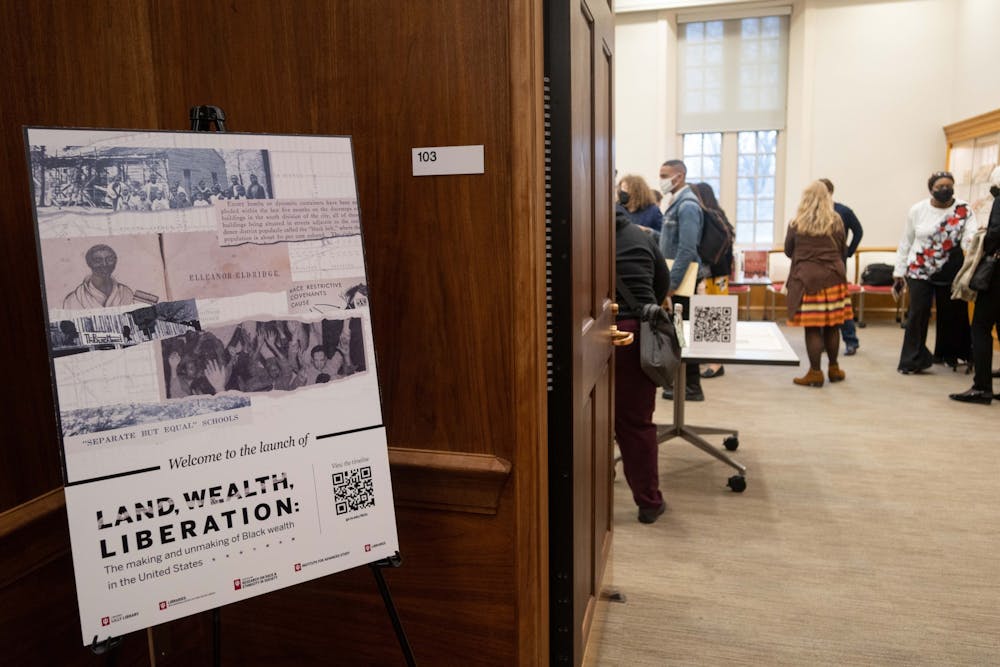Librarians across campus worked to compile a digital timeline called “Land, Wealth, Liberation: The Making and Unmaking of Black Wealth in the United States.” Students, faculty and others attended a pop-up exhibit of the archives March 24. The event featured a roundtable discussion featuring professor Valerie Grim and author Anna Gifty Opoku-Agyeman.
“We’re telling stories to humanize the people who went through these things,” Willa Tavernier, a research impact and open scholarship librarian at IU, said.
Tavernier said the researchers wanted to create a timeline to share accurate stories and resources from Black communities all over the country.
Tavernier said in an email the digital resources encourage readers to consider the role of systems of power, racism and violence against African Americans while evaluating arguments that blame them for their own community’s economic position.
The timeline includes the American Colonization Society and Missouri Compromise in 1820, the Civil War, Tulsa in 1921, the New Deal Era and a time period referred to as Urban Renewal, Tavernier said.
Tavernier said the researchers constantly added to the timeline which only contained 50-60% of their research.
She said Tulsa was called “Black Wall Street,” and the timeline explains the Tulsa Race Massacre of 1921 in greater detail.
Even though the massacre might have been the most widely known example of deliberate destruction in a Black economic community, Tavernier said many Americans still didn’t know anything about the massacre.
In the New Deal Era files, Tavernier said she found the language telling of aggression.
“If you read the FHA (Federal Housing Administration) document, it actually uses military language like ‘invasion of,’ ‘undesirable’ and ‘infiltrate that,’” Tavernier said.
Tavernier said there was proof of a lot of violence in the words coming from the people making housing policies and the mindset seemed elitist or tribal.
Tavernier said she hopes to look at police interactions with people of different socioeconomic statuses and how that evolved from the end of slavery to the present day.
“I didn’t realize that I knew things intellectually, but I hadn’t internalized how much everything is connected to all the things that happen in the past,” Ursula Romero, the public services librarian at the Lilly Library, said.
Romero said she had always found general facts of events in Tulsa and other places interesting. However, putting all those events together in the timeline showed her the cyclical nature of the history and treatment of Black communities in a way she hadn’t fully considered before.
Romero said the files show how the laws limited groups of people and caused outrage. Legalization qualified and systematically embedded limitations in our society, Romero said.
She said the research about the wealth gap played a big role in the timeline’s urban renewal section, and she wanted to effectively communicate the causes in this project.
Christina Jones, the head of the education library, said she tried to build and curate a children’s literature collection that teachers could use in the classroom.
She said she was motivated to find resources because she believes teachers have an important role in educating students on difficult and unpopular topics.
“History is marginalized,” Jones said. “It’s up to the teachers to locate information — primary sources and secondary sources — that are written for a student audience in a manageable way.”
Abby Martin, a secondary social studies education major, worked with the Education Library on this project. She said there was a shift to encourage historical inquiry and making personal connections with primary sources and other information.
Anna Long, another secondary social studies education major who also worked with the Education Library, said the project was enlightening. She said many topics like Tulsa were hardly discussed in classes, but they need to be addressed to acknowledge and interact with the history.
“Our hope is that we’ve started something and interested students and expert faculty will take what we’ve started and expand it,” Long said.




